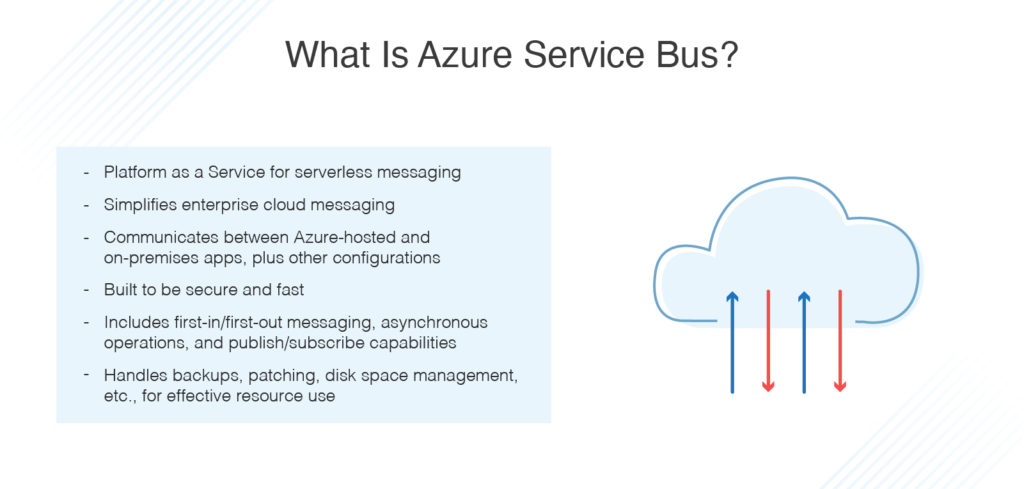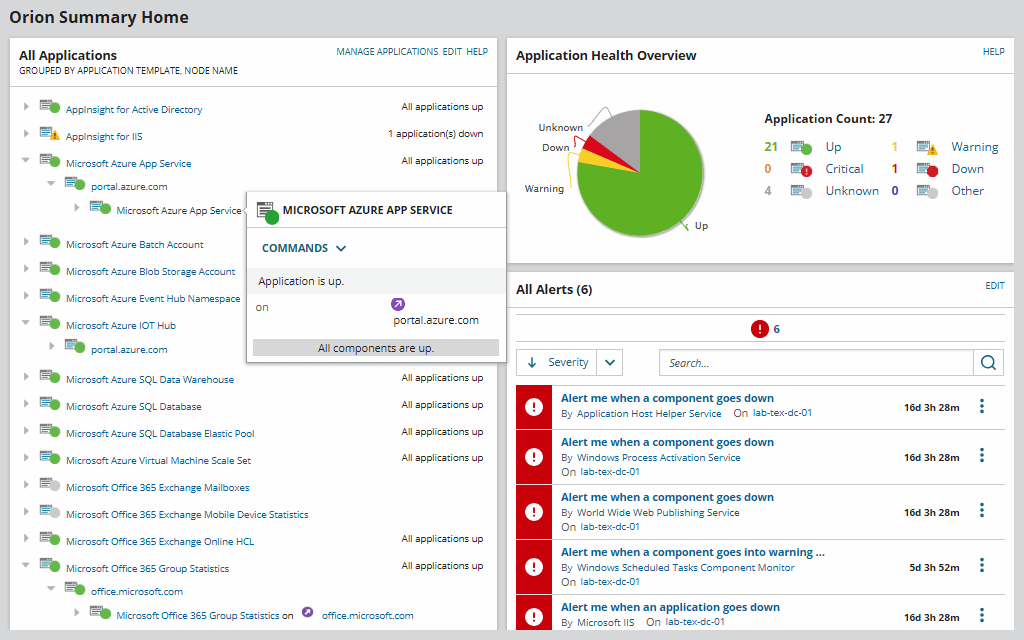Azure is a flexible and scalable cloud computing service announced in 2008, released in 2010 as Windows Azure, and renamed Microsoft Azure in 2014. While traditional IT infrastructure requires you to manage on-premises servers, Azure takes a cloud-based approach, so you can build, run, and manage your applications with a Microsoft-managed global cloud storage site. Azure hosts over 200 products and cloud services—including Azure Service Bus, a messaging service—and possesses more compliance certifications than other cloud providers.

Having a high-quality tool to monitor Azure can help your organization gain insights into your cloud workloads and Azure performance, so you can ensure things are running smoothly and identify any issues quickly. I recommend SolarWinds® Server & Application Monitor (SAM) for this purpose. This comprehensive server and application monitor offers monitoring templates for more than 1,200 other applications and systems, including many Azure services, Active Directory, Oracle WebLogic, MongoDB, and Microsoft Office 365.
What Is Azure Service Bus?
If you’re new to the Azure ecosystem, you may be wondering, “What is Azure Service Bus?”
Designed to provide secure messaging services between applications, services, and devices in the cloud and other applications and services, Azure Service Bus simplifies enterprise cloud messaging. Azure Service Bus provides first-in, first-out (FIFO) messaging, asynchronous operations, and publish/subscribe capabilities. Microsoft invests $1 billion in security annually to help protect your data from cyberthreats and meet compliance regulations, helping ensure this service is secure.
So, what is Azure Service Bus in simpler terms? Azure Service Bus is a Platform as a Service (PaaS) cloud computing service that offers “serverless” messaging. With Azure Service Bus, you don’t have to handle backups, patch products or operations systems, manage disk space, place logs, or worry about hardware failures. Microsoft will help take care of that, allowing you use your resources more effectively.
Azure Service Bus messaging is safe and fast. Each Azure Service Bus queue offers first-in, first-out message delivery, which means the messages are received and processed by the message receiver in the order they were added to the Azure Service Bus queue in the namespace. The Azure Service Bus queue technology facilitates communication between Azure-hosted apps and on-premises apps, web and worker roles, and a distributed application’s components—even if they’re running on-premises at different organizations.
All you have to do to get started with Azure Service Bus messaging is create and enable a Service Bus namespace with a unique name in the Azure portal. You can then create rules for regular senders and receivers and create Azure Service Bus queues. After setting up a Service Bus namespace, you can quickly and safely send messages (or data) between decoupled systems.
Azure Event Hub vs. Service Bus
If you’re familiar with the Azure ecosystem, you may be wondering when you might use Azure Event Hub vs. Service Bus. Both Azure Event Hub and Azure Service Bus are useful services, though they have slightly different purposes.
Event Hub was designed as a real-time data ingestion service capable of processing millions of events from software and devices per second. It’s secure, scalable, and simple to use, allowing users to quickly create real-time data pipelines and send data to storage or Event Hubs Capture, where you can use the same stream to process both batch-based and real-time based pipelines.
While Azure Event Hub was optimized for ingesting big data, Azure Service Bus was created to facilitate enterprise cloud messaging. Azure Service Bus messaging is secure, “serverless,” and offers many advantages. For example, Azure Service Bus provides tools for quickly mining and analyzing data to improve investment returns and forecasting.
Azure Service Bus Explorer
The Azure Service Bus Explorer allows users to connect with an Azure Service Bus namespace to execute, send, peek, and receive operations on messages. With Azure Service Bus Explorer, you can send messages to queues or topics, receive messages from a queue, a dead-letter queue, or a subscription, and peek messages from queues, dead-letter queues, or subscriptions.
Azure Service Bus Relay
Often, exposing services and applications in your corporate network to other on-premises environments or the public cloud means extensively modifying your corporate network infrastructure or opening one of your firewall’s ports, both of which present security risks. With Azure Relay—previously known as Service Bus Relay—you can safely subject your on-premises services and applications to the public cloud and other on-premises environments without drastically altering your corporate network infrastructure or introducing firewall holes.
Hybrid Connections
Instead of opening a port on your firewall, Azure Service Bus Relay’s Hybrid Connections feature uses web sockets or HTTP(S) to send requests and receive responses. The Hybrid Connections feature is compatible with all platforms and languages, making it incredibly versatile. With a single host:port combination, your services and applications can safely access the resources they need—whether those resources are in the public cloud or a different on-premises environment.
WCF Relays
With WCF Relays, you can securely introduce your corporate enterprise network’s Windows Communication Foundation (WCF) services to the public cloud. As with Hybrid Connections, you won’t need to open a firewall connection or make intrusive changes to your corporate network infrastructure.
Azure Service Bus Monitoring
Having a comprehensive Azure Service Bus monitoring tool can quickly give admins in-depth insights into Azure Service Bus, so they can ensure an organization is getting the most out of Azure Service Bus. I recommend SolarWinds Server & Application Monitor for your Azure Service Bus monitoring needs.
SolarWinds Server & Application Monitor

SolarWinds Server & Application Monitor (SAM) enables you to monitor exchanges between different devices, track your connectivity, and view metrics, so you can quickly identify irregularities. With end-to-end, continuous monitoring, customizable server monitoring, file monitoring software for servers, and application dependency mapping, SAM can fulfill your Azure Service Bus monitoring needs.
SAM offers over 1,200 monitoring templates, making monitoring environments across your organization’s IT infrastructure easy. In addition to providing several monitoring templates for Azure, SAM has monitoring templates for Cisco UCS servers, RabbitMQ, GlassFish servers, and more.
Summing Up Azure Service Bus
Cloud computing is becoming more popular as companies begin to shift away from more traditional IT infrastructure. Now that you know what Azure Service Bus is and why monitoring the Azure environment is crucial, all that’s left is to invest in an effective Azure environment monitoring tool.
Tools created for Azure monitoring are designed for easy customization, cover a wide range of monitored metrics, allow you to quickly react to problems with Azure performance, and facilitate the optimization of this environment. I feel SolarWinds Server & Application Monitor is one of the better developed solutions of this type on the market.
To summarize: SolarWinds Server & Application Monitor is a powerful tool built to provide end-to-end server monitoring, Azure monitoring, custom app monitoring, and more to ensure your servers and applications are running smoothly and you can quickly troubleshoot issues. See if SolarWinds Server & Application Monitor is the right choice for your organization with this 30-day free trial.
